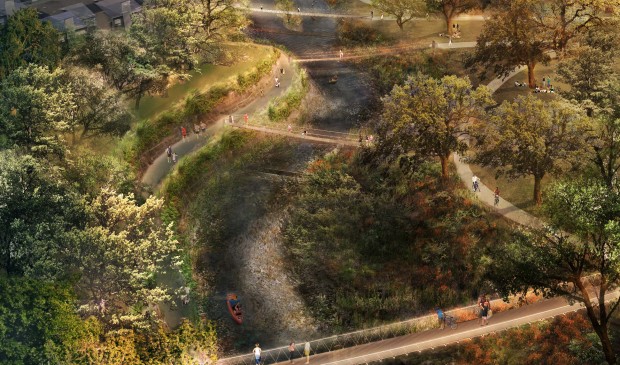Group pushing toward $220 million chain of parks downtown
Thursday, June 9, 2016 by
Jack Craver For once, a discussion of Waller Creek at City Hall was almost entirely upbeat.
City Council members were delighted during a work session Tuesday to hear an update on an ambitious $220 million project to create a long, narrow public space that stretches from Waterloo Park on 15th Street to Lady Bird Lake. The plan envisions adding 28 acres of public space along Waller Creek as well as 5 miles of hiking and bike trails to connect a chain of downtown parks.
All of the coming amenities will be made possible by the eventual completion of the Waller Creek Tunnel, which is intended to address the severe flooding that has eroded the creek bed in recent years.
Peter Mullan, who is leading the project as executive director of the Waller Creek Conservancy, a nonprofit group that was formed in 2011 to partner with the city on behalf of the project, came to Austin after overseeing the construction of New York City’s High Line, a 1.5-mile, elevated park that snakes through the Lower West Side of Manhattan.
At its core, he said, the project is about re-creating the natural landscape of Waller Creek that existed before it was ravaged by flooding. What has become an eyesore in many places will ideally be converted into a scenic gem around which a “multidimensional, urban ecosystem” will flourish, explained Mullan.
In many ways, he added, the Waller Creek project is even more ambitious than the High Line.
“We’re able to do so much for the people in so many different ways,” he said.
A big part of the project will be a revitalization of Palm Park, which Mullan described as a “gateway” to East Austin. The conservancy hopes that the historic Palm School building, which now abuts the park, will eventually be included in some capacity. The building currently houses the Travis County Health and Human Services Department, but the county has announced plans to move those offices elsewhere in the future.
The trail is anchored at the north end by Waterloo Park and the south end by Palm Park, but it also envisions the creation of at least two new parks in between with space for art installations, events and recreation.
Ideally, the Waller Creek project will help reconnect the divided East Austin and West Austin — divisions that many blame on Interstate 35. The park’s central location, said Mullan, is intended to serve as many people from as many areas of the city as possible, not just downtown residents. Indeed, the trail networks, as well as five lightweight bridges that will span the mouth of Waller Creek and a floating bridge that will connect both sides of Lady Bird Lake, are intended to increase connectivity throughout the city core.
That was a point that Council Member Ora Houston appreciated. The group’s outreach to a variety of different community groups around the city, she said, sent an important message to the community that the project “is not just about downtown. This is for all of us.”
Council Member Pio Renteria said hearing about the plans brought back fond memories of his childhood in East Austin.
“I grew up playing and swimming at Palm Park, and I used to explore the creek,” he said. “I’m looking forward to seeing it restored.”
Mayor Pro Tem Kathie Tovo said that the project plans had eased initial concerns among some in the community that the final product would resemble San Antonio’s commercially oriented River Walk, rather than a project focused on natural landscape and recreation.
“It’s an absolutely beautiful project,” said Mayor Steve Adler.
The project will be implemented in a number of phases. The first and current phase will cost $125 million, including $43 million in funds from the city and state, $50 million from the conservancy and $32 million from other sources, which Mullan suggested principally refers to developers, who he believes will contribute because of the economic development potential the revitalized corridor presents.
“We have been in discussions with them, and they are actually amenable to it,” he said. “They recognize the value that these surface improvements will make to their projects, so they want to be part of the solution as well.”
The funds raised by the Tax Increment Finance District that the city set up to finance the construction of the Waller Creek Tunnel will not be used to pay for the project.
The group began soliciting public feedback on plans for Waterloo Park in August and began a similar process for Palm Park last month. Currently, Waterloo Park has become a construction site for the tunnel. After the tunnel’s completion, the conservancy plans to go to work building the new park. The group plans to unveil Waterloo Park to the public in 2018 and to have the new and improved Palm Park ready by 2019.
Image courtesy of Michael Van Valkenburgh Associates/Waller Creek Conservancy.
You're a community leader
And we’re honored you look to us for serious, in-depth news. You know a strong community needs local and dedicated watchdog reporting. We’re here for you and that won’t change. Now will you take the powerful next step and support our nonprofit news organization?









